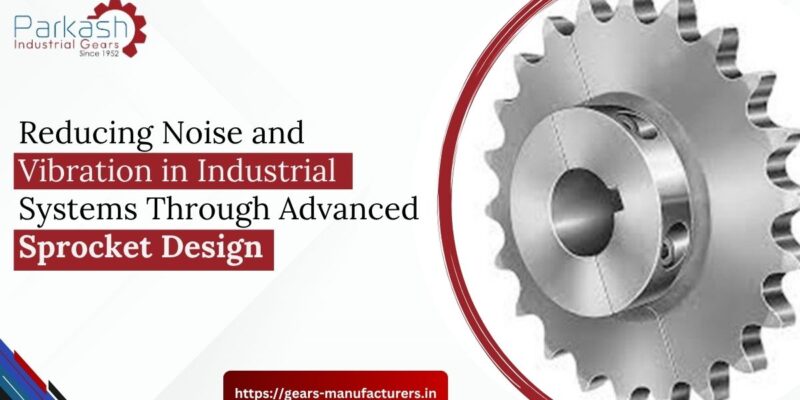
Reducing Noise and Vibration in Industrial Systems Through Advanced Sprocket Design
Industrial environments demand precision, efficiency, and reliability. One often overlooked aspect that significantly impacts operational performance is the noise and vibration generated by mechanical drive systems. Excessive noise and vibration not only create uncomfortable working conditions but also lead to premature equipment failure, increased maintenance costs, and reduced productivity. Advanced sprocket design has emerged as a critical solution to address these challenges, with leading sprocket manufacturer companies developing innovative approaches to minimize unwanted mechanical disturbances.
Understanding the Root Causes of Industrial Noise and Vibration
Industrial machinery generates noise and vibration through various mechanisms, with power transmission systems being primary contributors. Traditional sprocket designs often create periodic impacts between chain links and sprocket teeth, resulting in characteristic rattling sounds and mechanical vibrations that propagate throughout the entire system.
The geometry of conventional sprockets can create uneven load distribution, causing sudden engagement and disengagement forces that translate into vibrational energy. These disturbances are particularly pronounced in high-speed applications where the frequency of tooth engagement increases dramatically. Additionally, manufacturing tolerances and wear patterns can exacerbate these issues over time, leading to progressively worse noise and vibration characteristics.
Innovative Design Approaches for Noise Reduction
Advanced Tooth Profiling
Modern sprocket design incorporates sophisticated tooth profiling techniques that ensure smoother chain engagement. By optimizing the involute curve and implementing gradual engagement angles, engineers can significantly reduce the impact forces between chain and sprocket. This approach minimizes the sudden acceleration changes that typically generate unwanted noise.
The implementation of modified tooth profiles creates a more gradual transfer of power from one chain link to the next, distributing loads more evenly across multiple teeth simultaneously. This load sharing reduces peak stresses and eliminates the sharp impact characteristics that contribute to acoustic emissions.
Material Selection and Heat Treatment
The choice of materials plays a crucial role in vibration dampening. High-quality alloy steels with specific heat treatment processes not only enhance durability but also provide superior vibration absorption characteristics. Advanced metallurgical techniques create microstructures that naturally dampen vibrational energy while maintaining the strength required for heavy-duty applications.
Surface treatments such as shot peening and specialized coatings further reduce friction coefficients, contributing to smoother operation and reduced noise generation. These treatments also improve wear resistance, maintaining optimal performance characteristics throughout the component’s service life.
Precision Manufacturing: The Foundation of Quiet Operation
Leading gear manufacturing companies have recognized that precision in manufacturing directly correlates with operational quietness. Computer-controlled machining processes ensure consistent tooth spacing, accurate pitch diameters, and optimal surface finishes that contribute to smooth, quiet operation.
Modern manufacturing techniques employ multi-axis CNC machines capable of producing complex geometries with tolerances measured in micrometers. This precision eliminates the minor irregularities that can cause chain skip, uneven wear patterns, and the associated noise and vibration issues.
Quality control processes include comprehensive dimensional inspection, surface roughness measurement, and dynamic balancing procedures. These steps ensure that each sprocket meets strict specifications for concentricity, runout, and tooth-to-tooth variation, all of which directly impact noise and vibration characteristics.
Integration with Advanced Gear Systems
Helical Gear Applications
A reputable helical gear manufacturer understands that sprockets often work in conjunction with other gear systems. The integration of helical gears with optimized sprockets creates synergistic effects that further reduce system-wide noise and vibration. Helical gears naturally provide smoother torque transmission due to their gradual tooth engagement characteristics, complementing the benefits of advanced sprocket design.
The angular orientation of helical gear teeth distributes loads across multiple teeth simultaneously, similar to the load-sharing principles applied in modern sprocket design. This combination approach results in exceptionally quiet and smooth power transmission systems suitable for noise-sensitive industrial environments.
System-Level Optimization
Effective noise and vibration reduction requires consideration of the entire drive system, not just individual components. This holistic approach involves analyzing resonant frequencies, mounting configurations, and dynamic interactions between all system elements.
Parkash Industrial Gears exemplifies this comprehensive approach by offering integrated solutions that consider sprocket design within the context of complete power transmission systems. Their engineering team evaluates applications holistically, ensuring optimal component selection and configuration for minimum noise and vibration.
Benefits Beyond Noise Reduction
Enhanced Equipment Longevity
Reduced vibration directly translates to extended equipment life. Components subject to less vibrational stress experience lower fatigue rates, reduced bearing wear, and improved alignment stability over time. This longevity reduces total cost of ownership and minimizes unexpected downtime events.
Improved Working Environment
Lower noise levels create more comfortable working conditions, potentially reducing the need for hearing protection and improving worker productivity. Reduced vibration also minimizes the risk of structural fatigue in building frameworks and mounting systems.
Energy Efficiency Gains
Smoother operation typically requires less energy input due to reduced friction losses and more efficient power transmission. The elimination of vibrational energy represents recovered power that can contribute to meaningful energy savings in large industrial installations.
Future Trends in Sprocket Technology
The evolution of sprocket design continues with developments in computational fluid dynamics for noise prediction, advanced materials science, and additive manufacturing techniques. These technologies promise even greater noise and vibration reduction capabilities while maintaining the durability and reliability required for industrial applications.
Parkash Industrial Gears remains at the forefront of these developments, continuously investing in research and development to deliver next-generation solutions that meet the evolving needs of modern industrial operations.
Conclusion
Advanced sprocket design represents a proven pathway to significantly reducing noise and vibration in industrial systems. Through careful attention to tooth geometry, material selection, manufacturing precision, and system integration, today’s sprocket manufacturer can deliver solutions that transform noisy, vibration-prone operations into smooth, quiet, and efficient systems. The investment in quality sprocket technology pays dividends in improved working conditions, extended equipment life, and enhanced operational efficiency.

 FSC India.
FSC India.
This Post Has 0 Comments